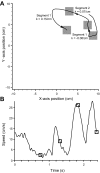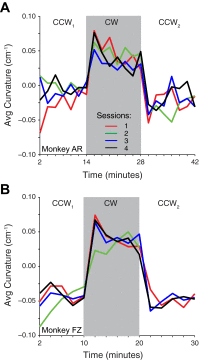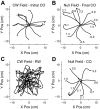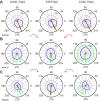Primary motor cortical discharge during force field adaptation reflects muscle-like dynamics
- PMID: 23657285
- PMCID: PMC3742991
- DOI: 10.1152/jn.00109.2012
Primary motor cortical discharge during force field adaptation reflects muscle-like dynamics
Abstract
We often make reaching movements having similar trajectories within very different mechanical environments, for example, with and without an added load in the hand. Under these varying conditions, our kinematic intentions must be transformed into muscle commands that move the limbs. Primary motor cortex (M1) has been implicated in the neural mechanism that mediates this adaptation to new movement dynamics, but our recent experiments suggest otherwise. We have recorded from electrode arrays that were chronically implanted in M1 as monkeys made reaching movements under two different dynamic conditions: the movements were opposed by either a clockwise or counterclockwise velocity-dependent force field acting at the hand. Under these conditions, the preferred direction (PD) of neural discharge for nearly all neurons rotated in the direction of the applied field, as did those of proximal limb electromyograms (EMGs), although the median neural rotation was significantly smaller than that of muscles. For a given neuron, the rotation angle was very consistent, even across multiple sessions. Within the limits of measurement uncertainty, both the neural and EMG changes occurred nearly instantaneously, reaching a steady state despite ongoing behavioral adaptation. Our results suggest that M1 is not directly involved in the adaptive changes that occurred within an experimental session. Rather, most M1 neurons are directly related to the dynamics of muscle activation that themselves reflect the external load. It appears as though gain modulation, the differential recruitment of M1 neurons by higher motor areas, can account for the load and behavioral adaptation-related changes in M1 discharge.
Keywords: curl fields; inverse dynamics model; monkey; reaching movements.
Figures












Similar articles
-
A muscle-activity-dependent gain between motor cortex and EMG.J Neurophysiol. 2019 Jan 1;121(1):61-73. doi: 10.1152/jn.00329.2018. Epub 2018 Oct 31. J Neurophysiol. 2019. PMID: 30379603 Free PMC article.
-
Visuomotor processing as reflected in the directional discharge of premotor and primary motor cortex neurons.J Neurophysiol. 1999 Feb;81(2):875-94. doi: 10.1152/jn.1999.81.2.875. J Neurophysiol. 1999. PMID: 10036299
-
Muscle and movement representations in the primary motor cortex.Science. 1999 Sep 24;285(5436):2136-9. doi: 10.1126/science.285.5436.2136. Science. 1999. PMID: 10497133
-
Neural Algorithms and Circuits for Motor Planning.Annu Rev Neurosci. 2022 Jul 8;45:249-271. doi: 10.1146/annurev-neuro-092021-121730. Epub 2022 Mar 22. Annu Rev Neurosci. 2022. PMID: 35316610 Review.
-
Limb movement: getting a handle on grasp.Curr Biol. 2004 Sep 7;14(17):R714-5. doi: 10.1016/j.cub.2004.08.046. Curr Biol. 2004. PMID: 15341763 Review.
Cited by
-
Differential Representation of Articulatory Gestures and Phonemes in Precentral and Inferior Frontal Gyri.J Neurosci. 2018 Nov 14;38(46):9803-9813. doi: 10.1523/JNEUROSCI.1206-18.2018. Epub 2018 Sep 26. J Neurosci. 2018. PMID: 30257858 Free PMC article.
-
Preferential encoding of movement amplitude and speed in the primary motor cortex and cerebellum.Hum Brain Mapp. 2017 Dec;38(12):5970-5986. doi: 10.1002/hbm.23802. Epub 2017 Sep 8. Hum Brain Mapp. 2017. PMID: 28885740 Free PMC article.
-
The influence of proprioceptive state on learning control of reach dynamics.Exp Brain Res. 2015 Oct;233(10):2961-75. doi: 10.1007/s00221-015-4366-x. Epub 2015 Jul 14. Exp Brain Res. 2015. PMID: 26169102
-
Independent representations of ipsilateral and contralateral limbs in primary motor cortex.Elife. 2019 Oct 18;8:e48190. doi: 10.7554/eLife.48190. Elife. 2019. PMID: 31625506 Free PMC article.
-
A Systematic Review on Muscle Synergies: From Building Blocks of Motor Behavior to a Neurorehabilitation Tool.Appl Bionics Biomech. 2018 Apr 22;2018:3615368. doi: 10.1155/2018/3615368. eCollection 2018. Appl Bionics Biomech. 2018. PMID: 29849756 Free PMC article. Review.
References
-
- Ajemian R, Bullock D, Grossberg S. A model of movement coordinates in the motor cortex: posture-dependent changes in the gain and direction of single cell tuning curves. Cereb Cortex 11: 1124–1135, 2001 - PubMed
-
- Alexander GE, Crutcher MD. Preparation for movement: neural representations of intended direction in three motor areas of the monkey. J Neurophysiol 64: 133–150, 1990 - PubMed
-
- Bhushan N, Shadmehr R. Computational nature of human adaptive control during learning of reaching movements in force fields. Biol Cybern 81: 39–60, 1999 - PubMed
-
- Brashers-Krug T, Shadmehr R, Bizzi E. Consolidation in human motor memory. Nature 382: 252–255, 1996 - PubMed
Publication types
MeSH terms
Grants and funding
LinkOut - more resources
Full Text Sources
Other Literature Sources

